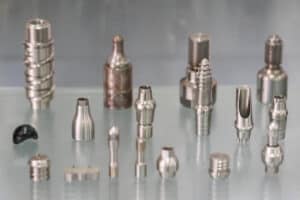Adding anodizing to aluminum parts can not only make up for the defects of surface hardness and wear resistance of aluminum parts, prolong the service life of aluminum parts, but also enhance the aesthetics of aluminum parts.
Therefore, adding anodizing to aluminum parts has almost become an indispensable part of the surface treatment of aluminum parts. In addition, anodizing is also the most widely used and successful surface treatment method for aluminum parts. Among the many aluminum parts we have produced in the past, 80%-90% of the aluminum parts have been anodized.
So in the factory, how is the aluminum part usually anodized? If you’re curious, keep reading and this article will take you through them.
Why anodize?
Aluminum parts have low density but high strength and good plasticity, and can be processed into various profiles. However, the surface hardness and wear resistance of aluminum parts can be further improved by anodizing, thereby effectively prolonging the service life of aluminum parts.
And anodic oxidation (in general, anodic oxidation refers to sulfuric acid anodic oxidation), is simply the electrochemical oxidation of metals or alloys.
Aluminum and its alloys, under the corresponding electrolyte and specific process conditions, will form an oxide film on the aluminum parts (anode) through the action of an applied current. This layer of oxide film has certain protective and decorative properties.
protective
The thickness of this oxide film formed on the surface of aluminum parts is about 5μm-30μm, and some special hard anodized films can be up to 25μm-150μm.
In addition, this oxide film can further improve the hardness and wear resistance of aluminum parts, which can reach 250kg-500kg/mm².
The heat resistance of aluminum parts has also been enhanced, and the melting point of the hard anodized film can even be as high as 2320K.
And it also makes the insulation of aluminum parts more excellent, and the breakdown voltage can be as high as 2000V.
At the same time, it also enhances the corrosion resistance of aluminum parts, and some aluminum parts can survive for thousands of hours in salt spray with ω=0.03NaCl without corrosion.
decorative
The oxide film formed on the surface of aluminum parts has a large number of micropores, which can absorb various lubricants, so that aluminum parts are very suitable as engine cylinder parts or other parts with high requirements on wear resistance;
The strong adsorption capacity also enables the surface of the aluminum parts to be easily colored, thereby further improving the decorative properties of the aluminum parts.
How is anodizing of aluminum parts done?
Step 1: Perform surface pretreatment
No matter what method is used to process aluminum materials and products, there will be some impurities and defects on the surface to varying degrees, such as dust, metal oxides (alumina films formed at natural or high temperature), tool residues Oil stains, asphalt marks, fingerprints caused by manual handling (the main components are fatty acids and nitrogen-containing compounds), welding fluxes, metal burrs, minor scratches, etc.
Therefore, before oxidizing the aluminum parts, it is necessary to clean the surface of the aluminum parts by chemical and physical methods. There are usually the following three steps: degreasing, alkaline etching, neutralized water cleaning.
Step 2: Anodizing
Anodizing aluminum parts is very simple, and the principle it is based on is essentially the principle of water electrolysis.
The aluminum piece is used as the anode and placed in the electrolyte solution. When current is passed, hydrogen gas is released at the cathode; part of the oxygen is released at the anode. This part of oxygen should not only have molecular oxygen, but also include atomic oxygen and ionic oxygen.
After that, the aluminum used as the anode is oxidized by the oxygen precipitated on it, thereby forming an anhydrous aluminum oxide film.
This aluminum oxide film actually consists of two layers. Due to the action of the electrolyte (here, the sulfuric acid solution is taken as an example), the weakest point of the membrane will be partially dissolved, and a large number of pores, that is, primary oxidation centers, will appear. This will bring the aluminum part into contact with the electrolyte flowing into the pores, so that the current can continue to conduct, and the newly generated oxygen ions will oxidize the new metal, expand around the bottom of the pore, and finally converge, where the old membrane and metal A new film is formed between them.
The third step: dyeing treatment
At present, the dyeing treatment of aluminum parts usually uses chemical coloring, which has the advantages of simple process, convenient operation, high efficiency and low cost, but when it is used for large-area coloring, it is prone to uneven coloring, easy decolorization, and light resistance. Poor problem, so currently it is mostly used for coloring small aluminum parts.
There are many ways to dye aluminum parts, which can also be simply divided into two types: organic dye dyeing and inorganic dye dyeing.
Here, we take the monochromatic dyeing of organic dyes as an example: the aluminum parts that have been anodized and washed with water are immersed in the dyeing solution of the specified temperature.
The dyeing time depends on the required color depth of the finished product, and the dye bath volume can be controlled at a ratio of 10:1 to the volume of the aluminum parts.
Step 4: Sealing the hole
In the second step, we mentioned that the aluminum oxide film formed on the surface of the aluminum part by anodizing has a lot of pores, so at the end of anodizing the aluminum part, we need to seal the aluminum part to prevent Improve the quality of aluminum parts and the firmness of dyeing.
After the sealing treatment, the surface of the aluminum parts will become uniform and non-porous, forming a tight oxide film. Dyes will also be deposited in this oxide film and will not fade easily. And the oxide film after the sealing treatment will no longer have adsorption, so as to avoid the adsorption of harmful substances, resulting in pollution or corrosion of the aluminum itself.
Commonly used sealing methods after coloring include hydration sealing, inorganic salt solution sealing, and transparent organic coating sealing.
We have already introduced how we anodize aluminum parts, and I hope the above content can be helpful to you.




